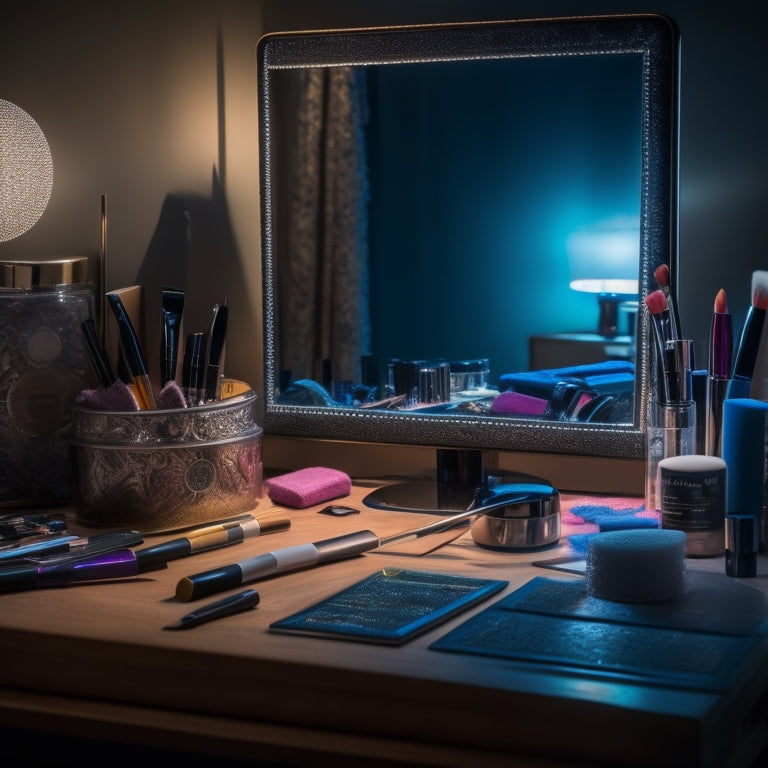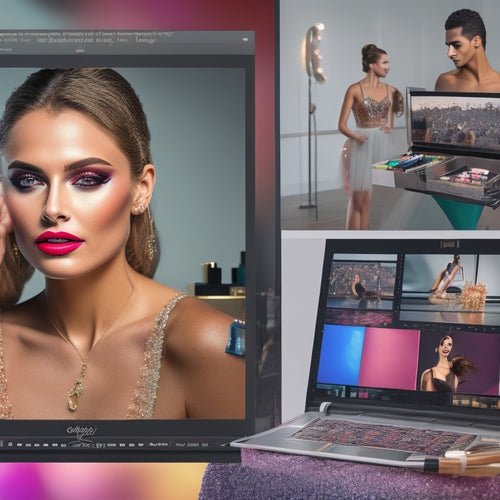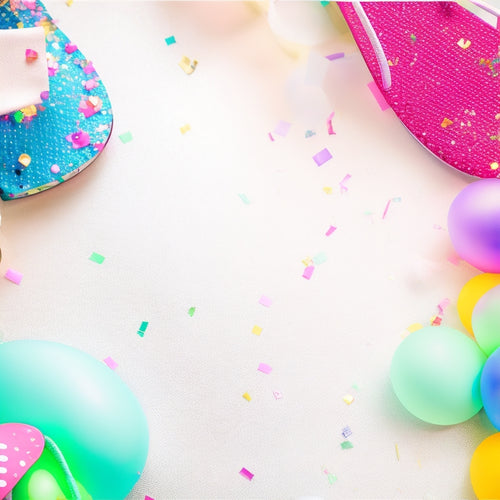
Why Perfect Dance Makeup Eludes So Many Beginners
Share
You're not alone in struggling to achieve flawless dance makeup. Lack of proper training is a major obstacle, with 8 out of 10 enthusiasts citing it as the primary reason. You might be unfamiliar with dance makeup basics, such as primer selection and application, highlighting, and contouring techniques. Perhaps you're using poor-quality brushes or haven't found the right foundation shade for your skin tone. Inadequate practice and feedback, unrealistic expectations, and insufficient knowledge of dance styles can also hinder your progress. To overcome these challenges and discover the secrets of perfect dance makeup, you'll need to address these areas and refine your skills.
Key Takeaways
• Lack of proper training and mentorship can hinder achieving flawless dance makeup, making it essential to prioritize instructor quality and certification paths.
• Inadequate understanding of makeup basics, such as primer selection and application, highlighting, and contouring, can lead to imperfect makeup.
• Improper product selection, including foundation shades and brush quality, can result in an unpolished finish.
• Insufficient practice and feedback can prevent beginners from refining their makeup techniques and identifying areas for improvement.
• Unrealistic beauty standards and pressure to conform can distract from focusing on personal progress, skill development, and embracing uniqueness.
Lack of Proper Training
If you're new to dance makeup, you may find that a lack of proper training is holding you back from achieving a flawless, stage-ready look. Don't worry, you're not alone! Many dancers struggle to master the skills needed to create a polished, performance-worthy appearance.
The good news is that there are numerous mentorship options, online courses, and training formats available to help you improve your skills.
When selecting a course or instructor, prioritize instructor quality and certification paths. Look for programs that offer thorough training, hands-on practice, and personalized feedback.
Online courses can be a convenient and flexible option, but make sure they include interactive elements, such as live sessions or video feedback, to maximize your learning.
Investing in proper training will pay off in the long run, giving you the confidence and skills to create stunning, stage-ready looks that enhance your performances. With the right guidance and practice, you'll be well on your way to becoming a dance makeup expert, capable of transforming your look and taking your performances to the next level.
Unfamiliarity With Dance Makeup Basics
Understanding the Makeup Fundamentals that form the foundation of a flawless dance makeup look is crucial for beginners. Without a solid grasp of these Beauty Essentials, you'll find it challenging to create a look that's both visually appealing and functional.
Here are four key areas to focus on:
-
Primer: Learning how to choose the right primer for your skin type and apply it correctly to create a smooth canvas for your makeup is imperative.
-
Highlight and Contour: Grasping how to use highlight and contour techniques to accentuate your features and create definition is vital.
-
Sweat-Resistant Finish: Mastering the techniques for creating a long-lasting, sweat-resistant finish that will withstand the demands of dance performances is crucial.
- Skincare: Developing a skincare routine that prepares your skin for makeup, ensuring a flawless base for your dance makeup look is important.
Poor Product Choices and Tools
When it comes to dance makeup, you're only as good as the products you use, and unfortunately, poor product choices can quickly ruin your look.
You might be using foundation shades that don't match your skin tone, or relying on low-quality brushes that streak and drag across your skin.
Wrong Foundation Shades
Selecting the wrong foundation shade is a common mistake that can instantly detract from your overall dance makeup look, and it's often due to poor product choices and inadequate tools. You might think you're doing everything right, but a foundation faux pas can throw off your entire look. This is known as Shade Shock, where your foundation is noticeably different from your skin tone, creating an unnatural appearance.
To avoid Shade Shock, make sure to:
-
Test foundation shades: Don't rely on online reviews or swatches; test foundation shades on your jawline to find the perfect match.
-
Consider your undertones: Are you cool, warm, or neutral? Choose a foundation that complements your skin's undertones.
-
Don't be afraid to mix: If you can't find a perfect match, mix two shades to create your ideal foundation color.
- Get a color match: Visit a makeup counter or consult with a makeup artist to get a personalized foundation match.
Inadequate Brush Quality
Poor brush quality can greatly compromise the overall finish of your dance makeup. Low-grade brushes can leave streaks, absorb excess product, and even cause skin irritation. You may think you're doing everything right, but subpar brushes can thwart your best efforts. It's vital to invest in high-quality brushes that are specifically designed for makeup application.
When selecting brushes, look for ones made from superior materials, such as natural fibers or high-quality synthetic materials. These will provide a smoother application and help you achieve a more uniform finish.
Additionally, proper Brush Care is essential to extending the life of your brushes and preventing the buildup of bacteria. Regularly wash your brushes with a mild soap and lukewarm water, and allow them to air-dry. This will help maintain their integrity and prevent damage.
Inadequate Practice and Feedback
When it comes to perfecting your dance makeup, you're likely to fall short if you're not dedicating enough time to practice in front of the mirror.
You need to regularly rehearse your makeup application to develop muscle memory and consistency, but an inconsistent rehearsal routine will only lead to subpar results.
Lack of Mirror Time
Inadequate mirror time can hinder your ability to perfect your dance makeup, as you're not allowing yourself sufficient opportunity to experiment, refine your techniques, and make adjustments based on real-time feedback. This lack of mirror time can lead to mirror anxiety, causing you to feel uneasy and uncertain about your makeup skills. Additionally, self-perception bias can also come into play, making you more critical of your work than necessary.
To overcome this, make sure to dedicate sufficient time in front of the mirror to practice and refine your techniques. Here are some tips to help you make the most of your mirror time:
-
Set aside dedicated time: Allocate a specific time slot each day or week to practice your dance makeup in front of the mirror.
-
Practice, practice, practice: The more you practice, the more comfortable you'll become with your makeup skills, and the more confident you'll feel.
-
Focus on one skill at a time: Concentrate on mastering one technique at a time, rather than trying to tackle multiple skills at once.
- Record yourself: Record yourself applying makeup and analyze the video to identify areas for improvement.
Inconsistent Rehearsal Routine
As you start perfecting your dance makeup, an irregular rehearsal routine can greatly impede your progress, causing you to struggle with even the simplest techniques and leaving you frustrated with your lack of improvement.
You might find yourself rushing through your morning routines, sacrificing valuable practice time for a few extra minutes of sleep. But, this inconsistency will ultimately hinder your growth as a dancer.
Rushed mornings can lead to sloppy technique, poor execution, and a lack of retention. Without a structured rehearsal schedule, you'll struggle to build upon previous lessons, making it challenging to master new skills.
Inconsistent practice also means inadequate feedback, as you won't have a clear understanding of what you're doing correctly or incorrectly. This lack of self-awareness will hinder your ability to adjust and improve.
Unrealistic Expectations and Pressure
Pressure to conform to unrealistic beauty standards can suffocate your creativity, making it difficult to focus on perfecting your dance makeup skills. As a beginner, you're already under pressure to master techniques and impress your audience. Add social media to the mix, and the stakes are even higher. You're bombarded with flawless, airbrushed images that set high standards for yourself, leading to personal anxiety.
To break free from this pressure, recognize the following:
-
Unrealistic beauty standards: Nobody wakes up looking like a social media influencer. Those images are heavily edited and staged.
-
Comparison is the thief of joy: Focus on your progress, not someone else's highlight reel.
-
Practice is key: Develop your skills, and your confidence will grow.
- Embrace imperfections: Your unique touch is what sets you apart, so own it!
Difficulty With Skin Tone Matching
Mastering perfect dance makeup requires a deep understanding of undertones, shades, and products in order to match your skin tone accurately. Finding the perfect match goes beyond just selecting a color that resembles your skin tone; it also involves considering the tone variation present within your complexion.
For example, you might've a warm undertone on your forehead but a cool undertone on your cheeks. Taking your complexion into account is crucial in selecting a product that accommodates these variations.
To tackle this challenge, start by identifying your undertones – whether they're warm, cool, or neutral. Once you have pinpointed this, you can start narrowing down your search for the ideal product. Seek out products that offer a variety of shades with different undertones, and don't hesitate to mix and match to achieve the perfect combination.
Insufficient Knowledge of Dance Styles
Your dance style heavily influences the type of makeup look that will complement your performance, yet many beginners overlook this essential factor when applying their dance makeup. Understanding your dance genre and its unique requirements is vital in achieving a flawless dance makeup look. As you evolve in your dance style, your makeup should adapt to complement your performance.
Here are 4 key dance genres and their corresponding makeup considerations:
-
Ballet: Soft, natural looks with a focus on enhancing your features without drawing attention away from the dance.
-
Hip-Hop: Bold, vibrant colors and dramatic eye makeup to match the high-energy performance.
-
Contemporary: Earthy tones and subtle shading to create a natural, effortless look that blends with the emotive dance style.
- Jazz: Bright, bold colors and defined features to match the energetic and lively atmosphere of the dance.
Inconsistent Makeup Application Techniques
As you master the makeup looks tailored to your dance genre, it's equally important to develop consistent makeup application techniques to guarantee a polished, professional finish. Inconsistent techniques can lead to an amateurish look, undermining your overall performance.
Rushed strokes, uneven blending, and sloppy application can make your makeup look unrefined, even if you've chosen the perfect shades and products.
To avoid this, focus on developing a smooth, deliberate touch when applying makeup. Practice blending colors seamlessly, and take your time to make sure each feature is enhanced without harsh lines or abrupt changes.
Invest in good-quality brushes and tools, and learn how to use them effectively. Remember, it's not just about the products you use, but also how you use them.
Frequently Asked Questions
How Do I Create a Natural Everyday Look for Dance Performances?
As you step into the spotlight, envision a flawless, radiant you. To create a natural everyday look for dance performances, you'll enhance your features by matching your skin tone with foundation, adding subtle definition with bronzer and blush.
Can I Use Regular Makeup for Dance Performances or Is Special Makeup Required?
When you're about to take the stage, you wonder if regular makeup will cut it, but let's face it, you need high-quality, sweat-resistant makeup to guarantee your stage presence shines, and special dance makeup is designed to provide just that.
What Are the Best Makeup Brushes for Applying Dance Makeup?
As you progress from novice to pro, you'll realize that mediocre brushes won't cut it; invest in high-quality brushes with synthetic fibers for seamless blending, and prioritize regular Brush Cleaning to maintain Brush Quality.
How Do I Remove Dance Makeup Without Damaging My Skin?
"When removing dance makeup, you'll want to prioritize gentle, sensitive skin-friendly methods. Reach for oil-based makeup wipes specifically designed for sensitive skin, and gently sweep them across your face to dissolve and lift away stubborn makeup without stripping your skin of its natural oils."
Are There Any Specific Makeup Rules for Different Dance Genres?
When dancing, you'll find specific makeup rules vary by genre: for Ballet Basics, focus on natural, understated looks, while HipHop Highlights demand bold, vibrant colors and dramatic eye shadow to accentuate your moves.
Related Posts
-

Learn Dance Makeup Artistry Online: A Step-by-Step Guide
You're about to begin an exciting journey to master the art of dance makeup online! First, you'll need to select the ...
-

Top New Balance Dance Shoes for Comfort and Performance
If you're on the hunt for top New Balance dance shoes that maximize comfort and performance, consider models like the...
-

Get the Dance Floor Popping: Wedding Flip Flops Sign
Create a memorable and entertaining wedding reception with a 'Get the Dance Floor Popping' flip flops sign that combi...


